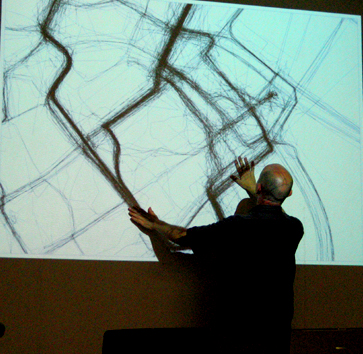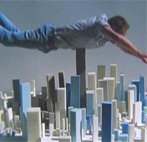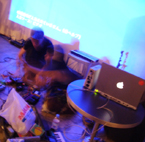revealing radford
How can we use art and in particular media art to express our relation to our community? How can we express the history and memory of a place?

This project took place over 8 weeks between October and December 2006 at Radford Care Home, working with a group of 12 senior citizens from the area to explore the changes which the area has undergone, the personal histories attached to different places and hopes of how the area might develop in the future.

The project mixed simple media technologies with craft based techniques
Plate decoration // Painting/drawing // Clay modeling // embroidery // Mapping // Sound recording // Video // Photography
The project was described as thus:
We want to create a big, beautiful map of the area, with as many contributions from you as possible. This is not an ordinary street map but a map which is full of ideas of the past, present and future, a map which is personal to those who make it. Map of colourful pictures, arts and crafts, video, sound and photos – a collage of many different materials, which allows you to represent Radford and wider Nottingham as you like.
We would like you to be our tour guides – to take us on a journey through your words and pictures – a journey through how Nottingham used to be, what it is like now and how you hope it will be in the future.
mapping

We began the project by looking at old maps of the area dating as far back as 1850’s to see how places have changed. It was fascinating to see in these maps whole areas of forest and untouched land become railways, roads, houses and factories. We tried to locate the present day in the maps of the past and to imagine what was in a particular space over 100 years ago.
We discussed what a map represents, different methods of mapping and what kind of information a map contains. Examining codes and how we read maps through a variety of symbols we began to make our own symbols and meanings to create our own personal maps.
We concluded that maps do not have to be concerned with the physical structure of an area and that we can communicate many other things through them such as Sound/ Emotion/ Smell/Memory
*
drawing

We began to investigate memories of places and expression through the use of drawing, including materials such as charcoal, pastels, colouring pencils. Drawing can be a useful tool to communicate a feeling about a place in which it is not necessary to accurately represent form but can be used as expression for collecting ideas, images and senses. Some participants were quite nervous to be asked to draw something, feeling they did not have any skill in this field, so it was important to make them feel comfortable in exploring different ways of drawing
The subjects of the drawings included: The first house you lived in Nottingham * Your street * Your journey from one place to another in Nottingham * Places which give you a particular feeling in the area * Favourite places * How you would like Nottingham to be.
**
walking

We went out in small groups to walk around the neighbourhood and used this opportunity to introduce video cameras and digital cameras for the purpose of recording the participants’ experience. Together we were able to explore the local area allowing us have a shared experience of a particular place
We discussed about likes/dislikes about the area, how it has changed and how we would like it to change.
This was also an opportunity to consider how we can record the area around us and our interactions with it. and how can this be communicated to other people.
*
recording

Photography
Each participant was given a disposable camera and asked to take pictures of the area in which they live, their everyday spaces and the places important to them. We then developed these photos and examined them as a group, discussing the relevance of each picture, why it was taken and what meaning it holds.
Sound
When introducing sound recording to the group we discussed about the sounds in the area. Sound in the city is a phenomena which may rarely contemplate until it intrudes upon us but there are sounds that we hear everyday and may impact upon us subconsciously. We considered the frequent sounds in the area. Also disturbing sounds and pleasant sounds. We also tried to recollect sounds which were once heard often but now no longer exist in the neighbourhood. We then spent time listening to the sounds around us and recorded some of these.
consultation
In preparation for this project I consulted with Jeanie Finley a Nottingham based artist and film maker. She developed three year project called ‘tea-toast-technology’ working with senior citizens in care homes to create a digitally based art work. She gave much advise of working with communities and making participants comfortable with new ideas/experiences. She stressed the importance of building up a relationship with that community, with its individual members and also making your purpose very clear.
community
There have been many studies made on art community projects and much commentary made upon them. The positive potential of such projects and their good intentions have been recognised by many, but these form of projects have also been strongly criticized.
Miwon Kwon comments on the problematics of working with community in ‘One place after another’, highlighting the challenge of even defining what constitutes a community ‘The ambiguity of the term “community” which is consistent with the discursive slippage around “audience” “site” and “public” is itself a distinctive trait of community-based public art discourse’ (2004: 94). Community is a construct largely of imagination, it may be defined through physical locality or by ‘community of mythic unity’. But such unity is also challenged by Jean-Luc Nancy, who has commented ‘there is no communion, there is no common being, but there is being in common’, he proposes that community is not created through homogeneity but through the shared experience of difference. The Inoperative Community, 1982.
Kwon goes on however to acknowledge the social motivations of many community projects which in ‘The highlighting of marginalized and disenfranchised social groups in community-based collaborative art projects is indeed an attempt to counter these groups’ lack of social visibility and political power.’ P.114. This is a movement which began to gain particular impetus since the sixties, with a strong footing in the UK as Lucy Lippard highlights in the ‘Lure of the Local’. ‘The lure of the local is not always about home as an expressive place, a place of origin and return. Sometimes it about the illusion of home, as a memory. If place is defined by memory, but no one who remembers is left to bring these memories to the surface, does a place become noplace, or only a landscape. What if there are people with memories but no-one to transmit them to? Are their memories invalidated in being unspoken? Are they still valuable to others with a less personal connection?' (1997: 23). This comment is particularly relevant to the project Revealing Radford, which in part attempts to express the memories attached to a particular place, to share these with others in a communication which aims to deepen appreciation of a local area. But also emphasises the individual's investigation of their own personal memories, which is not necessary accompanied with the objective of informing the general public of these experiences.
Putting in long-term local stints on everything from playgrounds to parades, they were not limited to a single work or a single site, and could get to know the place and the people, facilitating a broader and more varied display of communal expression. Much community art is an attempt to restore a context to our deracinated notion of art. Community artists help the local stories emerge. They see themselves as facilitators or animators rather than as interpreters or creators of expressions and impressions. Community arts draw upon cultural resources by encouraging people to exchange accounts of their own lived experiences and histories. The concept of the artist as ‘cultural worker’ providing necessary local labour on the creative front has been the generating concept for many urban activist artists since the sixties. (2004: 267).
But the position of the artist entering a community is a very sensitive one as Hal Foster comments in ‘The Artist as Ethnographer’, the ‘Artist typically an outsider trying to engage the locals in the production of their (self) representation. The quasi-anthropological role set up for the artist can promote a presuming as much as a questioning of enthnographic authority, an evasion as often as an extension of institutional critique.” (1996:197) Paraphrasing Pierre Bourdieu he highlights “ethnographic mapping is predisposed to a Cartesian opposition that leads the observer to abstract the culture of study. Such mapping may thus confirm rather than contest authority of mapper over site in a way that reduces the desired exchange of dialogical fieldwork.” (1996: 190) ref Bourdieu Theory of Practice. Such community projects then can have a detrimental impact, especially when the motivations of all parties are not transparent. Ideally in any such collaboration there needs to be a long term commitment, particularly from the artists involved to maintain a consistent relationship with those that they are working with. To go into a community, make some brief activity and then leave has no sustained input or outcome. It is perhaps regrettable that we could not work for a longer period of time with the members of the Radford Care Group. The short term nature of the project was of course made clear from the start of the project, however a longer-term relationship of cooperation and collaboration would have realized deeper meaning and benefit for the participants.
In many community projects there are a string of agendas at play which can in fact become detrimental to the main intention of such projects. As Kwon also highlights, such projects may not actually tackle issues which communities are facing head on, but only make them more passive in their reception of certain conditions 'Furthermore, as some artists have noticed, community-based art can function as a kind of “soft” social engineering to defuse rather than address community tensions and to divert, rather than attend to, the legitimate dis-satisfaction that many community groups feel in regard to the uneven distribution of existing cultural and economic resources'. (Kwon 2004: 153)
This may be presenting a rather pessimistic view of community arts, however it is important to critique such a model and to be wary of an impetuous embracing of promises of bringing immediate new found benefits and communication to groups through such activity.
the map
The project was presented as an investigation into local history articulated through a form of mapping. It is relevant here to consider the discourse surrounding mapping and the representation of place. Many locative media projects have been criticised for taking a very indexical approach to place and geography, applying systematic cartographic representation more often or not through the latest mobile and GPS devices. Locative media projects have led to much discussion about the function of the map, what it expresses but also what it destroys.
We may naturally begin with reference to Jorges Lois Borges’ tale in ‘Of Exactitude in Science’ in which an empire is covered by a map of itself ‘...In that Empire, the craft of Cartography attained such Perfection that the Map of a Single province covered the space of an entire City, and the Map of the Empire itself an entire Province. In the course of Time, these Extensive maps were found somehow wanting, and so the College of Cartographers evolved a Map of the Empire that was of the same Scale as the Empire and that coincided with it point for point. Less attentive to the Study of Cartography, succeeding Generations came to judge a map of such Magnitude cumbersome, and, not without Irreverence, they abandoned it to the Rigours of sun and Rain. In the western Deserts, tattered Fragments of the Map are still to be found, Sheltering an occasional Beast or beggar; in the whole Nation, no other relic is left of the Discipline of Geography.’ from J. L. Borges, A Universal History of Infamy, Penguin Books, London, 1975.
The map functions as a representation, Borges comments upon man’s pursuit of perfection in science. But if we recreate an exact copy of that which we wish to represent, meaning is lost in representation. As Baudrillard emphasised in Simulation and Simulacra representation increasingly supplants reality, reality is in fact manipulated to align with the representation, not the reverse.‘Today abstraction is no longer that of the map, the double, the mirror, or the concept. Simulation is no longer that of a territory, a referential being or substance. It is the generation by models of a real without origin or reality: A hyperreal. The territory no longer precedes the map, nor does it survive it. It is nevertheless the map that precedes the territory - precession of simulacra - that engenders the territory. (Baudrillard, 1994: 1)’
Roland Barthes in ‘Semiology and the Urban’ equates the modern map with effective censorship, the map must accurately represent the physical layout of space, with uniformity and precision, in which place is reduced to coordinates and contours. ‘scientific geography and in particular modern cartography can be considered as a kind of obliteration, of censorship that objectivity has imposed on signification’ p.166 ‘there is a conflict between signification and reality itself, at least between signification and that reality of objective geography, the reality of maps.’ P.168 The unreality of maps, their abstraction and severe representation again leading to the loss of the real, the diversity and intangibility of place. This is furthered in de Certeau's critique of the map as a 'totalizing device' which 'collates on the same plane heterogeneous places’, homogenizing that which should exist in difference.
David Harvey also draws attention to the objectification of space through mapping, but points out that in centuries past mapping contained many subjective expressions of culture and religion. 'In the relatively isolated worlds of European feudalism, place assumed a definite legal, political and social meaning indicative of a relative autonomy of social relations and of community inside roughly given territorial boundaries. Within each knowable world, spatial organization reflected a confused overlapping of economic, political, and legal obligations and rights. External space was weakly grasped and generally conceptualized as a mysterious cosmology populated by some external authority, heavenly hosts, or more sinister figures of myth and imagination.' (1990: 240) However since the Renaissance, new qualities of objectivity, practicality and functionality came to be valued in cartography 'because of accuracy of navigation, the determination of property rights in land, political boundaries, rights to passage and of transportation.' Therefore maps became stripped of imagination, fantasy and religious belief, and the traces of the experiences incurred in their very production, becoming abstract and 'strictly functional systems for the factual ordering of phenomena in space.' It is this abstraction which also allows for the assertion of power, as in order for space to be controlled it must be pulverized and fragmented, reified in terms which delimit space into that which is 'stable and knowable' p.254.
Revealing Radford aims to find another form of expression which can be related to cartography but does not intend to plot every point, to fix place by a set of coordinates and freeze it in a single form of representation but rather pursues the objective of tracing experience and relationships which formulate and are formulated by place, drawing attention to the complexity and depth of these elements.








